
Lead Generation|Marketing|Sales|Warm Leads
B2B Lead Generation 101: Strategies, Best Practices, and Software
B2B Lead Generation 101: Strategies, Best Practices, and Software
2019-06-12

Lead Generation|Marketing|Sales|Warm Leads
B2B Lead Generation 101: Strategies, Best Practices, and Software
2019-06-12

Lead Generation|Marketing|Sales|Warm Leads
B2B Lead Generation 101: Strategies, Best Practices, and Software
2019-06-12
Table of Contents
Auto Generated TOC
Auto Generated TOC
Auto Generated TOC
Auto Generated TOC
You know that a full sales pipeline is imperative for business growth. Without an airtight system for B2B lead generation in place, you’re sure to slow down your already hard-working sales team.
At first, B2B lead generation might seem like a complex process, but don’t let that discourage you. In this article, you’ll learn the three essential components you must have for an effective system of B2B lead generation:
Lead Investing strategy - the digital channels you use to attract your clients
Best practices - the details you must include to make sure those channels work well
Tools - the software that will ensure your system is optimized and automated
With these components in mind, you’ll be able to craft a system that appeals to your ideal buyers and starts generating leads quickly and with less effort. Also put effort in your local lead generation..
What is B2B lead generation?
B2B lead generation is the process of identifying new prospects for your sales team to pursue. It includes three main stages:
Gaining prospects’ attention and guiding them to your site, often through content marketing or traditional advertising
Capturing their information with a lead magnet, form, or by identifying anonymous website visitors on your site
Assessing that information to determine which are the highest quality leads
An optimized lead generation strategy can deliver increased ROI for your marketing budget by filling a sales pipeline on autopilot. It saves your sales team the frustration of cold calling or cold emailing, helping keep productivity and morale high.
The Top Strategies for B2B Lead Generation
There are several different strategies for gaining prospects’ attention. Which of the following or combination of the following you should use will depend upon the online behavior of your ideal buyer.
Social Media
If the user is interested in learning more about the product or service, they click the ad and a form appears. Facebook pre-populates the form with their information so there are only a few taps between you and a newly qualified lead.
Secret Entourage, a mentorship service for entrepreneurs, reportedly restructured and streamlined their ad strategy by focusing on Lead Ads. Compared to their original campaign, the new one led to 40% more purchases with 88% fewer ad sets. They were also able to lower their cost per purchase by 10%.While this case study shows promise, the average click-through rate (CTR) of Facebook ads for B2B companies is 0.78%. While the average CTR across all industries is 0.9%.
A more effective platform for social media ads may be LinkedIn. (Source) Although similar in form and function to Facebook image ads, LinkedIn ads are proven to generate more leads for B2B companies. According to the company’s content marketing blog, 80% of B2B leads generated through social media come from LinkedIn.It makes sense why. A sizable chunk of LinkedIn users are in the position to make purchasing decisions for their companies. Of its 500 million members, 61 million are senior-level influencers and 40 million are decision makers.Several case studies back up the claim that LinkedIn is the king of B2B marketing on social media. Simplus, a Salesforce partner, saw 70% of their website form fills come directly from LinkedIn. As a result, they’re shifting most of their ad spend to the platform.HubSpot took a look at their customer’s results with LinkedIn Sponsored Content and found similarly promising results:
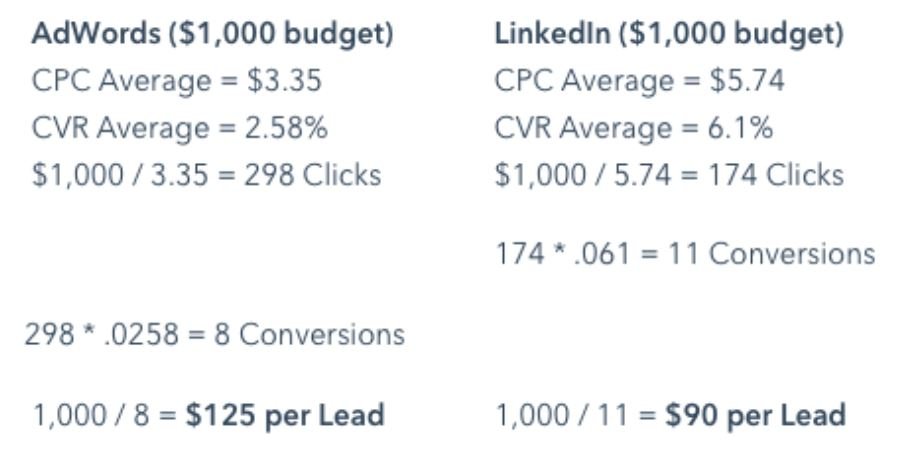
While LinkedIn has a higher cost per click (CPC) than Google Ads, the conversion rate is twice as high. This leads to a lower cost per lead overall.
PPC Ads
Don’t write off Google Ads or other pay-per-click (PPC) ads just yet. These are some of the most popular channels for lead generation. And there are benefits to having them as a part of your lead generation strategy.
The average conversion rate for B2B industries is 3.04% in the search network and 0.8% in the display network.
While both the CTR and conversion rate for B2B ads is lower than most other industry averages, there are countless case studies out there that demonstrate the effectiveness of PPC ads for B2B businesses.
Digital marketing agency SevenAtoms executed a campaign that included Google Ads for Imperva Incapsula, a cyber security SaaS company. The results speak for themselves:

Mn this case, it definitely paid for Imperva Incapsula to have an experienced agency on their team to get the most out of their PPC ad budget.
If you’re interested in other PPC ad options, consider review directories such as FinancesOnline, G2, or Capterra. These platforms can have lead conversion rates as high as 24%. Making them solid alternatives for companies who are more concerned about their budget.
Capterra is a review directory dedicated to software, making it the perfect choice for SaaS companies. In Capterra, companies can pay to be a sponsored post so they rank at the top of a search:
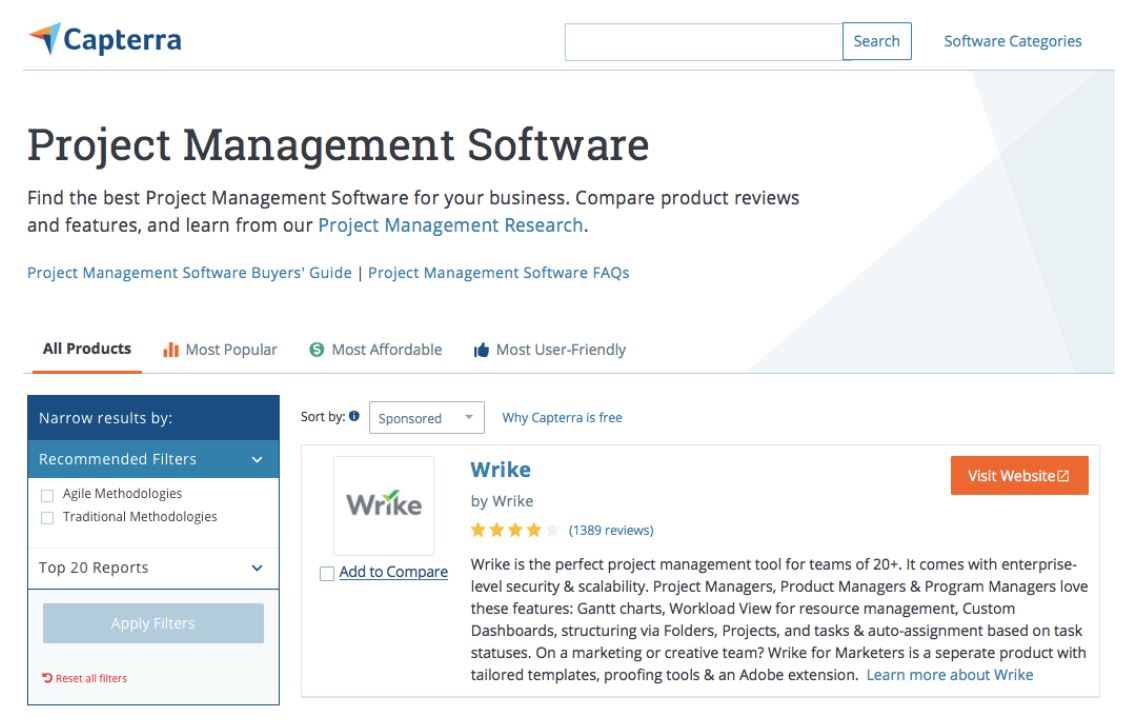
The “Visit Website” button in this example takes visitors to a landing page tailor-made for that ad. Leads acquired through this channel are clearly searching for a software solution, making them highly qualified.
Blogging
Blogging is a popular method of content marketing for B2B companies, and for good reason. It gives businesses a chance to:
Answer prospects’ questions
Demonstrate their expertise
Show what makes them unique in a sea of competitors
Provide excellent service before any money has ever changed hands
To a potential customer, all these qualities can help increase their trust in your business. Provided you give them an opportunity to fill out a form for more information somewhere within the blog post or on the page, blogging can be an effective way of collecting leads.
They were also able to increase organic traffic by 182%, ensuring that their visibility on search engines would continue to grow.
HubSpot also knows that blogging is a major asset for their business. 90% of their leads each month come from posts on HubSpot that were published months or years ago.
No matter the changing trends in social media or content marketing, email and email tracking pixel continue to be a valuable form of lead generation and nurturing. For every dollar spent on email marketing, businesses can earn $43.
In order to stand out, it pays to be thoughtful about the quality of emails you’re sending. There’s no sense in flooding a subscriber’s already crowded inbox.
Hammock, a B2B content marketing agency, thought creatively about its newsletter. It came up with the !dea Email, or one “bright idea” in a single email. Each email includes a single landscape image accompanied by about 350 words of copy.
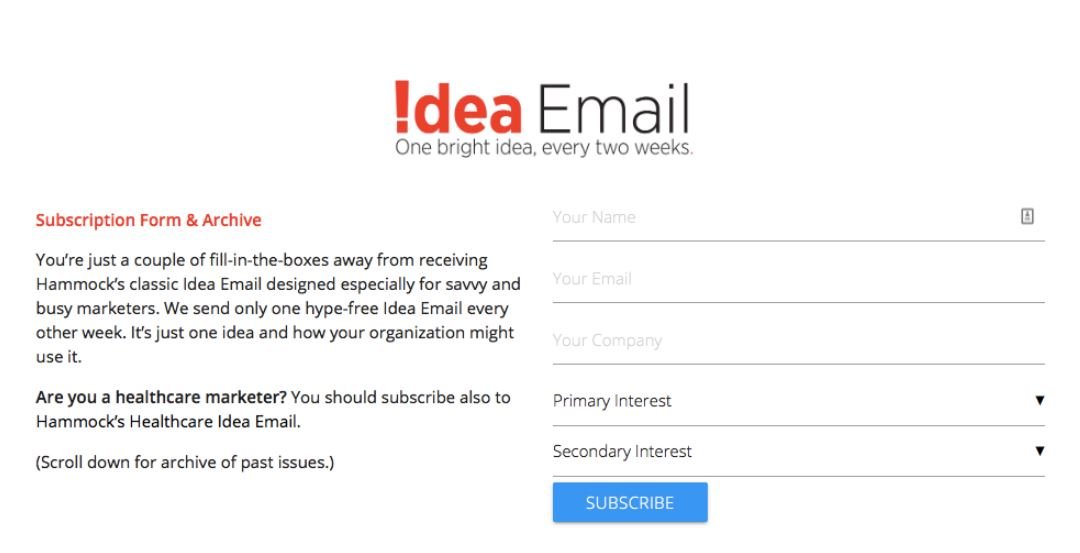
By focusing on a simple, interesting concept sent every two weeks, Hammock was able to boost their open rates by 48%. They cut through the clutter of subscribers’ inboxes by adhering to the principle of more is less.
The 8 Best Practices for B2B Lead Generation
Now that you know the strategies of lead generation, it’s time to hone in on the details. These best practices will make sure your system for lead generation is airtight.
Tailor Marketing to Different Buyer Personas
Your business should have at least one buyer persona so that you know exactly how to structure your marketing and lead generation efforts. Knowing your ideal buyer will help you know where you should direct your ad spend. And also what kind of content you should be creating to attract them.Not all prospects with decision-making or purchasing power will have the same online behaviors. For example, Pew research found that Twitter usage among U.S. adults drops as age increases. On the other hand, 61% of LinkedIn users are in the 30 to 64-year-old age range. You may be able to reach some mid-level decision makers on Twitter, as well as some senior-level influencers on LinkedIn.
Be Mobile-Friendly
If there’s only one best practice to follow, let it be this one.
In 2018, 52.2% of all website traffic worldwide was generated by mobile users. That means there’s a good possibility that over half of the visitors to your site could be viewing it on their phone.
If your site isn’t built to be mobile-friendly, then chances are you’re losing a devastating amount of leads - and sales.
Optimize Your Website
Even if your site has a professional design and is mobile-friendly, you still might be losing visitors before they have a chance to become viable leads. Use Google Analytics to view an overview of behavior flow so you can see exactly where and how much traffic is dropping off.
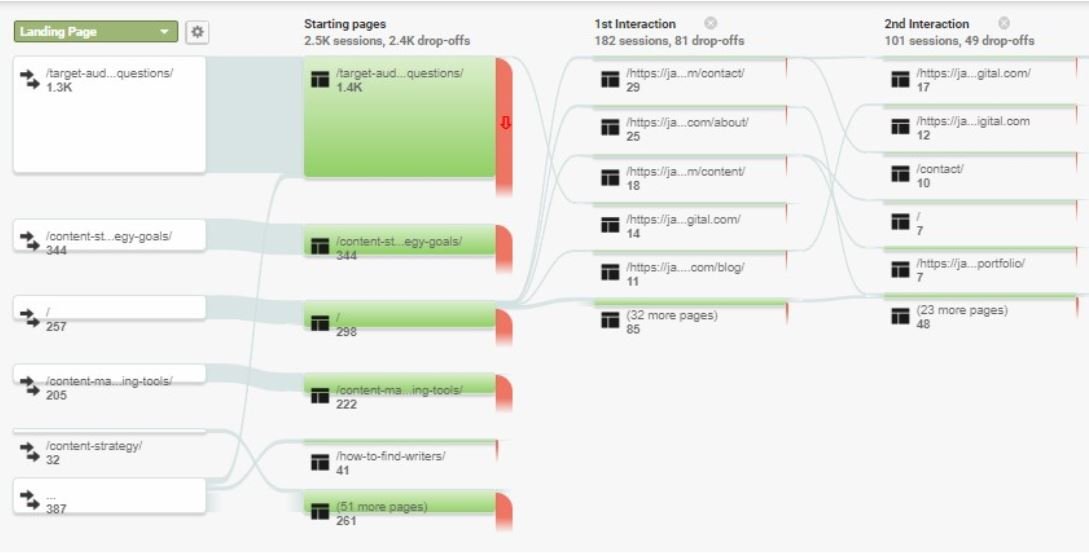
This will help you hone in on what pages are attracting and retaining visitors, and what pages still need some work. You can then use tools like Hotjar (discussed in a later section) to get even more specific and discover exactly what elements on a page are working well and what needs to be updated.
Use Video Content
There are a few powerful statistics that suggest that video content can drive significant traffic for your website. A white paper from Cisco states that internet video traffic made up 69% of all global consumer internet traffic in 2017. Meanwhile, a report from HubSpot showed that when given the choice to skim or consume thoroughly, 55% of users will pay close attention to video - more than any other type of content analyzed.
Create Long-Form Blog Content Consistently
Just because video is a powerful content marketing tool doesn’t mean that you should ignore blogging. Long-form content is still king when it comes to generating traffic from search engine results. In fact, posts with at least 2,000 words are more likely to rise to the top of search engines than any other article length. Keywords alone won’t ensure the top spot on search engines. To increase your ranking, create high-quality articles and guides on a regular basis so that Google knows your site is relevant and engaging. This also increases your brand awareness and credibility with leads.
Capture Leads on Every Site Page
Your blog and video content gives visitors a reason to come to your site, so be sure to give them an opportunity to stay. At least one newsletter sign-up form, comment form, trial sign-up button, or other lead capturing form should be available on each page of your site.To make capturing leads through forms even more effective, structure your content so that it naturally segues into the sign-up form. Be sure to test and analyze how well each page or post is at capturing leads, then adjust accordingly
Use Lead Magnets
Lead magnets are offers such as white papers, ebooks, or other free resources that are used to entice visitors into giving you their information. These resources also help you qualify leads, as they can help indicate the lead’s needs and pain points.To create an irresistible lead magnet, follow these examples and come up with a resource that solves a problem, is specific, easy to digest, and has high actual and perceived value.
Score Captured Leads
Not all leads are created equal. Lead scoring is the process of generating a number, typically between one and 100, that shows just how qualified that lead is. The process can be done manually with a formula, although this is time-consuming and has a lot of variables.Luckily, there are some options for automating the lead scoring process, as you’ll see in the next section.
The 8 Best Tools for Optimizing B2B Lead Generation
All these strategies and best practices might seem overwhelming, but there are several tools to help you automate, execute, and optimize your lead generation strategy. Best of all, many of these tools are free or free to get started.
Best Lead Scorer: LeadBoxer
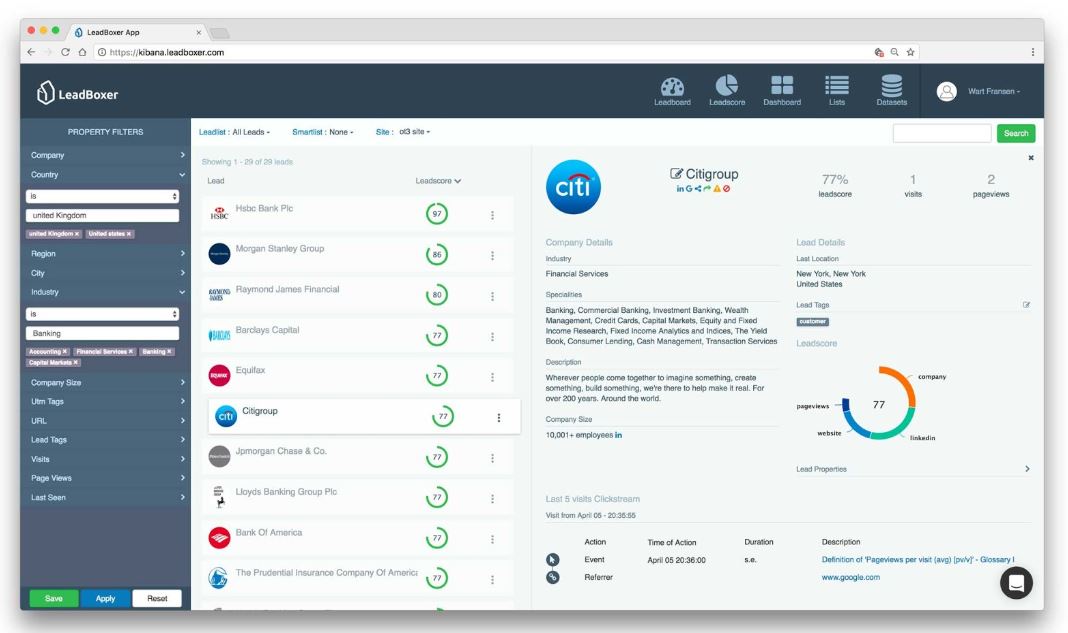
LeadBoxer doesn’t just score leads captured through forms or lead magnets on your site. It’s able to identify 50% of site visitors who would otherwise remain anonymous. Not only that, it can populate data such as contact information, the prospect’s industry, and their specialty.
LeadBoxer also tracks visitors’ online behavior while they engage with your brand (website visits, social media engagement, email opens, ad clicks, etc.) It uses this information to automatically calculate a lead score, which tells your sales team who is most likely to convert.a
This saves your team time, increases sales, boosts morale, and ultimately saves you money.
Best Landing Page Creator: Instapage

Price: Professional Plan - $11.25/month, Turbo Plan - $41.25/monthFree trial: Yes + limited free forever planWhat it’s all about: LimeLeads is a great tool for sales prospecting as it doesn’t cooperate with fake data.
The tool was built by a bunch of B2B marketing veterans that were sick of a lack of credible data being available. Its main goal is getting you prospect lists that are accurate.
The tool integrates with CRMs and will enable sales teams to put together a list of prospects in 30 seconds or less.
Salespanel.io
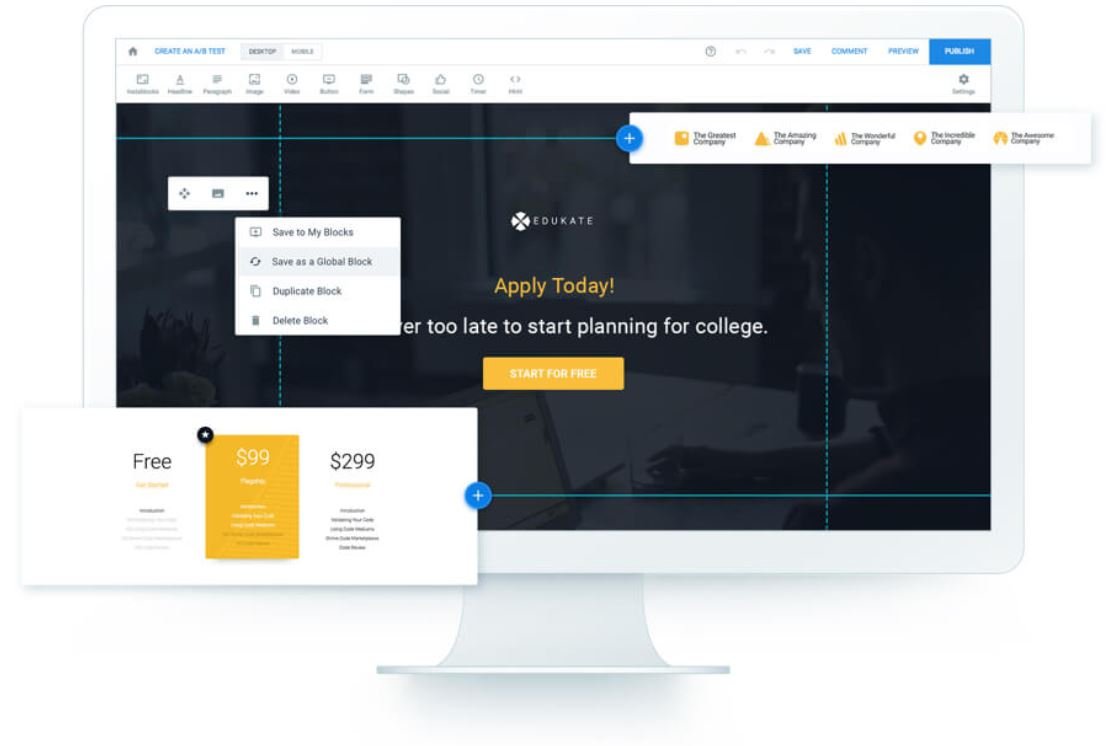
Thanks to an intuitive interface and a slew of features, Instapage is the perfect tool for building landing pages that integrate seamlessly with your PPC advertising campaign.You can easily optimize pages for lead generation by using features like heatmaps, A/B testing, mobile-responsive pages, and drop-in pixel tracking for easy remarketing. Best of all, Instapage’s drag-and-drop interface is user-friendly, negating the need for a web designer to get your campaign started.
With Instapage, you can create several landing pages that are individually tailored to target unique buyer personas, all with a few clicks of the mouse.
Best Site Optimizer: Hotjar
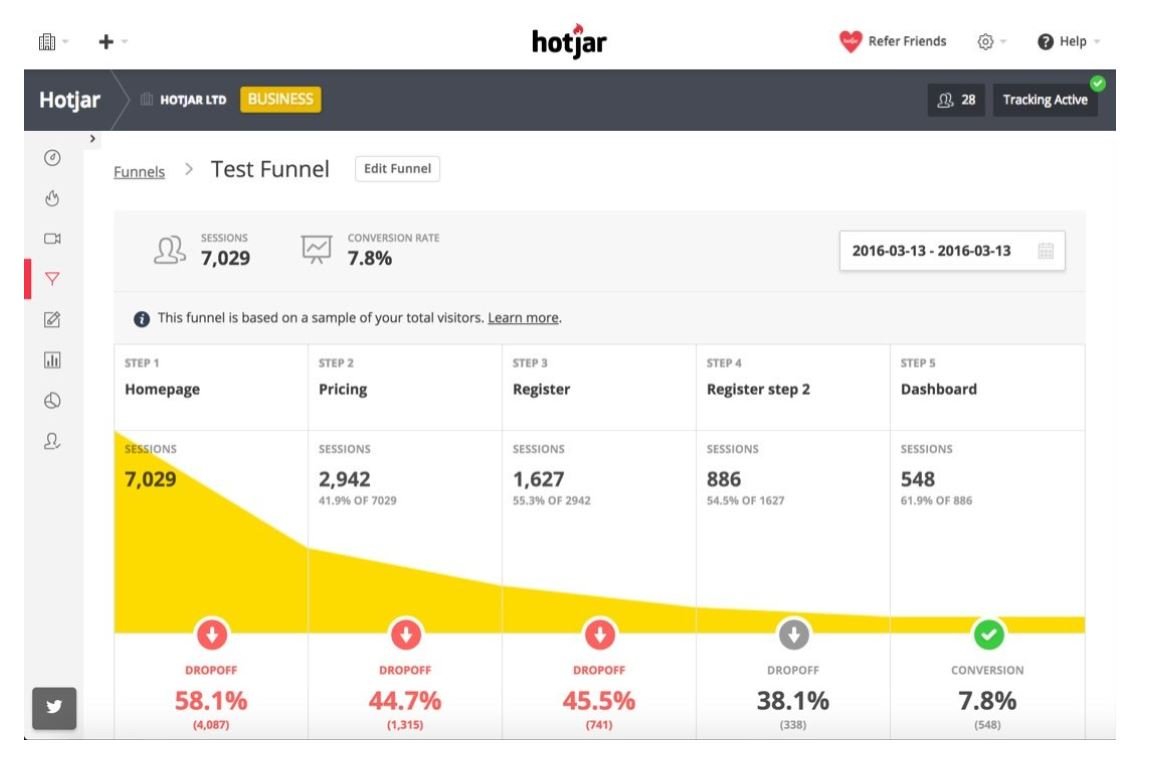
While Instapage has several features that help you create optimized landing pages, you need to make sure the rest of your website is working just as hard for your business. A well-optimized website is an essential part of the user experience and can generate more leads, regardless of whether or not they discovered your brand through a landing page.Hotjar tracks users’ journeys through your site and shows you exactly where they’re dropping off and why. Powerful tools like heatmaps, visitor recordings, form analysis, and feedback polls eliminate all the guesswork about why certain visitor behavior is happening and what can be done to improve their journey.
Best Social Media Automation: Buffer
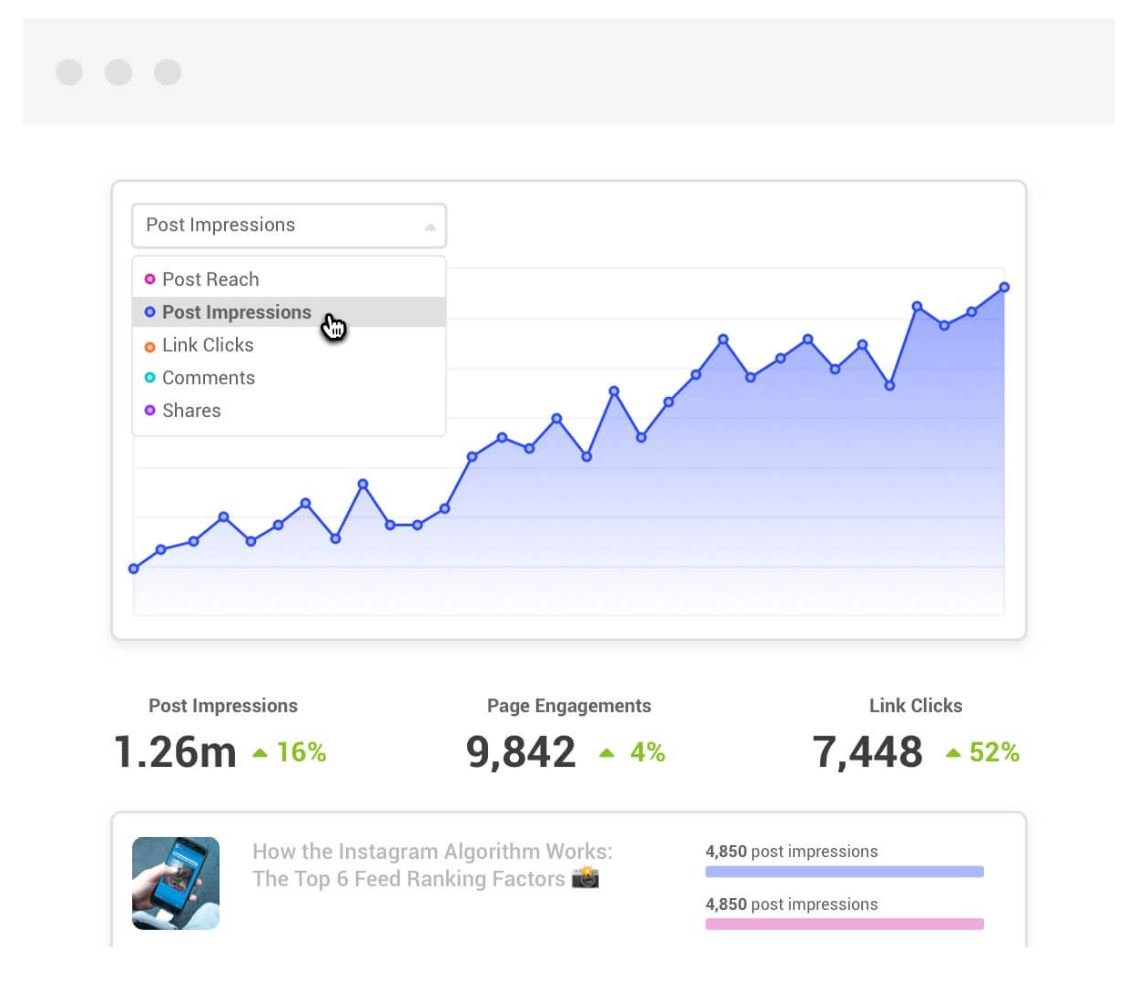
A robust social media presence helps your business establish credibility and trust. Luckily, you don’t need an overly complex strategy or need to devote a lot of time and manpower to sustaining your social presence.
A tool like Buffer keeps all your posts organized and automated. Use it to schedule posts in advance, then review the analytics to see how well posts are performing.
Buffer also collects conversations from your followers in one inbox, making it easy to respond to questions or comments about your business.
Best Content Planner: Google Analytics and Keyword Planner
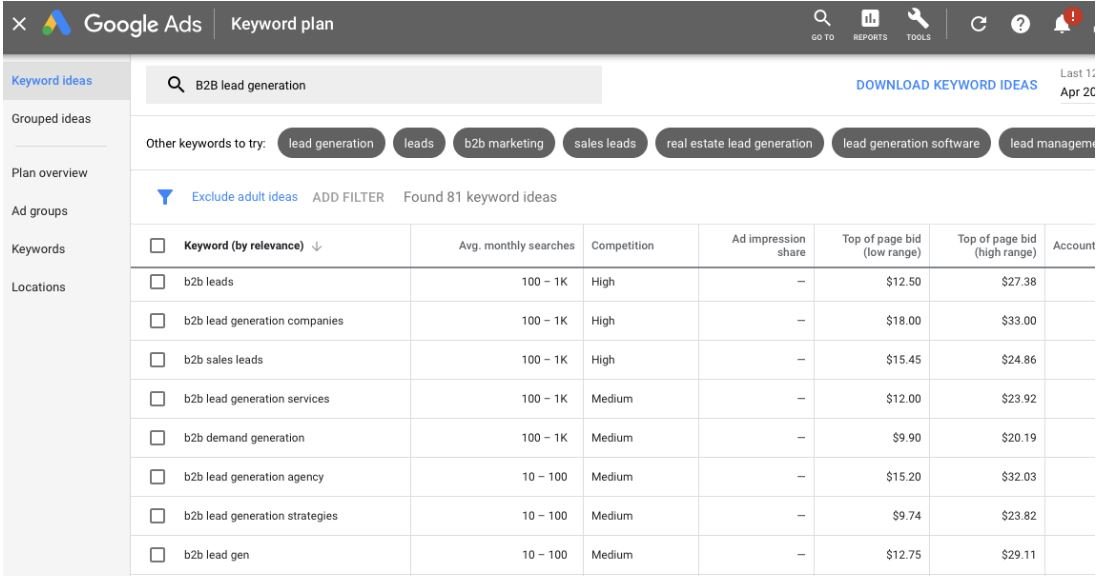
Creating high-quality blog content that visitors will find extremely useful and interesting is one of the best ways to attract new leads. Free tools like Google Analytics and Keyword Planner can help you pick article topics that are sure to perform well.
Keyword Planner is actually a function of Google Ads, but it can help you pick blog topics, too. Use it to check out average monthly searches and competition for a potential keyword and its variations. You can quickly see if there’s an interested audience, room to rise to the top of the search page, or a keyword variation where your future content might perform better.
With Google Analytics, you can observe user behavior on your site and see what content you’ve previously published is performing the best. With this insight, you can plan follow-up content to build on the success you’ve already had.
Best Email Drip: Mailchimp
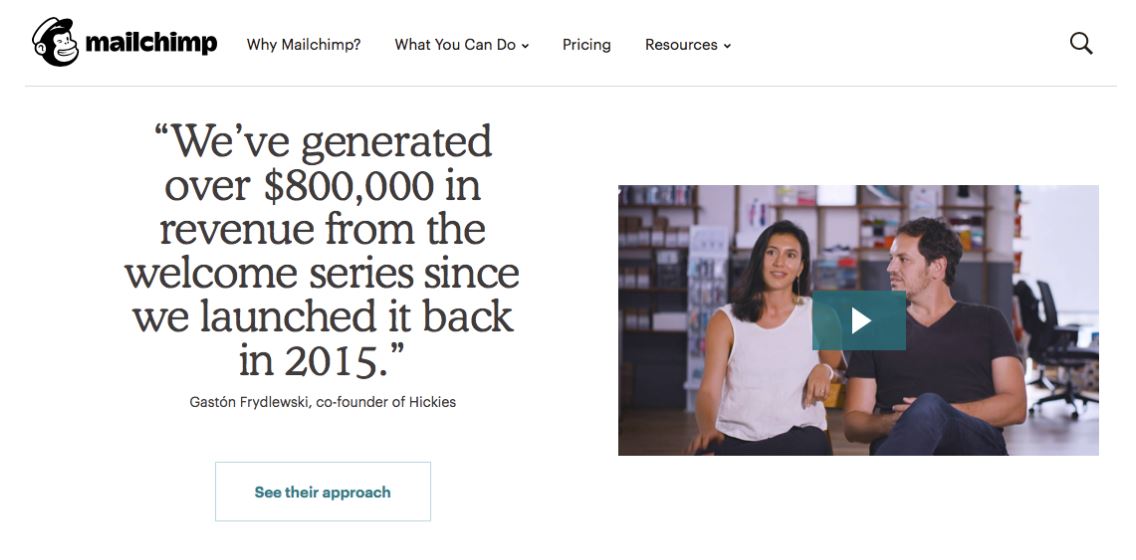
One of the best ways to nurture leads and keep your brand top-of-mind is through email campaigns.
Mailchimp makes it easy to visualize, create, and test welcome email sequences designed with conversions in mind. It also collects and analyzes information about how subscribers are interacting with your emails. Helping you optimize and create more effective campaigns.Mailchimp integrations with most of the tools in the average B2B marketing stack. For example, data about your subscribers’ email behavior can automatically sync with lead scoring software like LeadBoxer. By this giving you even more insights about leads.
Best CRM: HubSpot

A customer relationship management (CRM) tool is necessary for tracking potential prospects and keeping a record of all their details.
HubSpot’s sales software is an extremely powerful tool that starts at $0/month. It’s able to track lead behavior on your website, then send personalized email sequences based on their actions.
HubSpot also tracks where leads are in their buyer journey, helping you visualize your pipeline at a glance. Integrate HubSpot with some of your other tools, such as LeadBoxer, to get an even better idea of who’s ready to convert and who needs a little more nurturing.
Best Pitch Assistant: Crystal
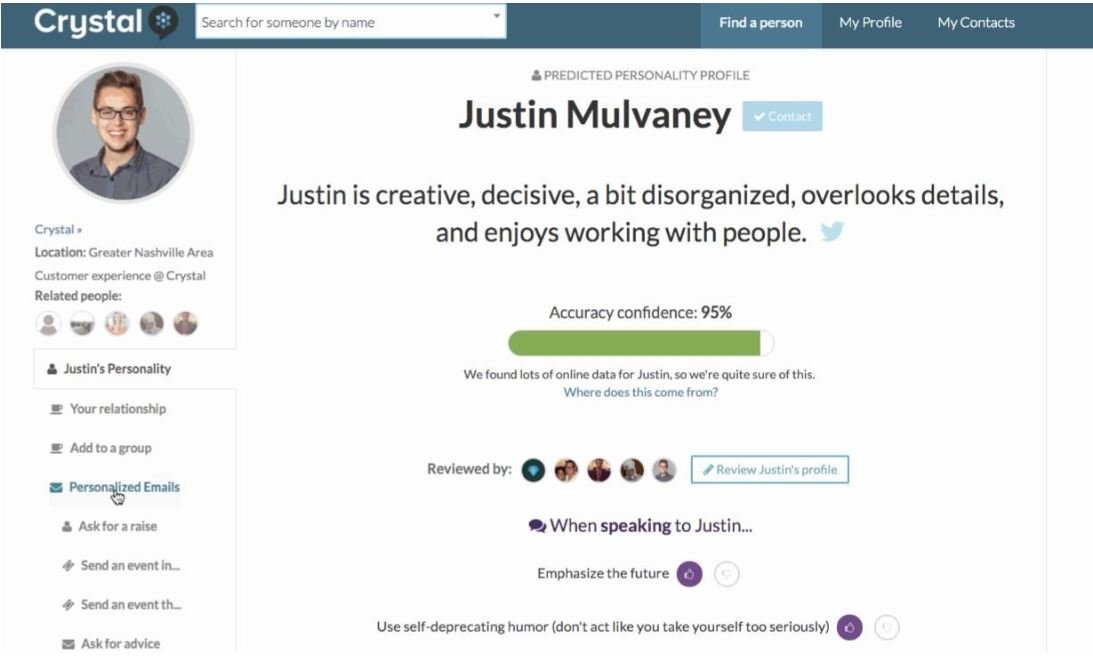
It’s time to turn your leads into clients. Take all the guesswork out of how to pitch to them by using a tool like Crystal.
Crystal analyzes a prospect’s LinkedIn profile, then provides actionable insights about their personality based on what kinds of posts they’re writing and engaging with. It also collects the feedback of people who have previously interacted with that person, increasing the accuracy of the assessment.
Use Crystal to decide the best ways for communicating with a prospect, that way you’re never flying blind when entering a sales meeting.
Grow Your Sales with Strategic B2B Lead Generation
Automatically generating leads for startups and others is the key to closing more deals and growing your business. There are several different strategies you can take. But the ones you choose will ultimately hinge upon the online behavior of your ideal buyers.By following the best practices and using some of the tools outlined in this article, you’ll soon have an optimized, automatic system for generating and scoring leads that keeps working even when you’re not. Sales enablement tools can help you make this process even better.The next time you log back on, there’ll already be several prospects with high lead scores ready for you to reach out to.Schedule demo
You know that a full sales pipeline is imperative for business growth. Without an airtight system for B2B lead generation in place, you’re sure to slow down your already hard-working sales team.
At first, B2B lead generation might seem like a complex process, but don’t let that discourage you. In this article, you’ll learn the three essential components you must have for an effective system of B2B lead generation:
Lead Investing strategy - the digital channels you use to attract your clients
Best practices - the details you must include to make sure those channels work well
Tools - the software that will ensure your system is optimized and automated
With these components in mind, you’ll be able to craft a system that appeals to your ideal buyers and starts generating leads quickly and with less effort. Also put effort in your local lead generation..
What is B2B lead generation?
B2B lead generation is the process of identifying new prospects for your sales team to pursue. It includes three main stages:
Gaining prospects’ attention and guiding them to your site, often through content marketing or traditional advertising
Capturing their information with a lead magnet, form, or by identifying anonymous website visitors on your site
Assessing that information to determine which are the highest quality leads
An optimized lead generation strategy can deliver increased ROI for your marketing budget by filling a sales pipeline on autopilot. It saves your sales team the frustration of cold calling or cold emailing, helping keep productivity and morale high.
The Top Strategies for B2B Lead Generation
There are several different strategies for gaining prospects’ attention. Which of the following or combination of the following you should use will depend upon the online behavior of your ideal buyer.
Social Media
If the user is interested in learning more about the product or service, they click the ad and a form appears. Facebook pre-populates the form with their information so there are only a few taps between you and a newly qualified lead.
Secret Entourage, a mentorship service for entrepreneurs, reportedly restructured and streamlined their ad strategy by focusing on Lead Ads. Compared to their original campaign, the new one led to 40% more purchases with 88% fewer ad sets. They were also able to lower their cost per purchase by 10%.While this case study shows promise, the average click-through rate (CTR) of Facebook ads for B2B companies is 0.78%. While the average CTR across all industries is 0.9%.
A more effective platform for social media ads may be LinkedIn. (Source) Although similar in form and function to Facebook image ads, LinkedIn ads are proven to generate more leads for B2B companies. According to the company’s content marketing blog, 80% of B2B leads generated through social media come from LinkedIn.It makes sense why. A sizable chunk of LinkedIn users are in the position to make purchasing decisions for their companies. Of its 500 million members, 61 million are senior-level influencers and 40 million are decision makers.Several case studies back up the claim that LinkedIn is the king of B2B marketing on social media. Simplus, a Salesforce partner, saw 70% of their website form fills come directly from LinkedIn. As a result, they’re shifting most of their ad spend to the platform.HubSpot took a look at their customer’s results with LinkedIn Sponsored Content and found similarly promising results:

While LinkedIn has a higher cost per click (CPC) than Google Ads, the conversion rate is twice as high. This leads to a lower cost per lead overall.
PPC Ads
Don’t write off Google Ads or other pay-per-click (PPC) ads just yet. These are some of the most popular channels for lead generation. And there are benefits to having them as a part of your lead generation strategy.
The average conversion rate for B2B industries is 3.04% in the search network and 0.8% in the display network.
While both the CTR and conversion rate for B2B ads is lower than most other industry averages, there are countless case studies out there that demonstrate the effectiveness of PPC ads for B2B businesses.
Digital marketing agency SevenAtoms executed a campaign that included Google Ads for Imperva Incapsula, a cyber security SaaS company. The results speak for themselves:

Mn this case, it definitely paid for Imperva Incapsula to have an experienced agency on their team to get the most out of their PPC ad budget.
If you’re interested in other PPC ad options, consider review directories such as FinancesOnline, G2, or Capterra. These platforms can have lead conversion rates as high as 24%. Making them solid alternatives for companies who are more concerned about their budget.
Capterra is a review directory dedicated to software, making it the perfect choice for SaaS companies. In Capterra, companies can pay to be a sponsored post so they rank at the top of a search:

The “Visit Website” button in this example takes visitors to a landing page tailor-made for that ad. Leads acquired through this channel are clearly searching for a software solution, making them highly qualified.
Blogging
Blogging is a popular method of content marketing for B2B companies, and for good reason. It gives businesses a chance to:
Answer prospects’ questions
Demonstrate their expertise
Show what makes them unique in a sea of competitors
Provide excellent service before any money has ever changed hands
To a potential customer, all these qualities can help increase their trust in your business. Provided you give them an opportunity to fill out a form for more information somewhere within the blog post or on the page, blogging can be an effective way of collecting leads.
They were also able to increase organic traffic by 182%, ensuring that their visibility on search engines would continue to grow.
HubSpot also knows that blogging is a major asset for their business. 90% of their leads each month come from posts on HubSpot that were published months or years ago.
No matter the changing trends in social media or content marketing, email and email tracking pixel continue to be a valuable form of lead generation and nurturing. For every dollar spent on email marketing, businesses can earn $43.
In order to stand out, it pays to be thoughtful about the quality of emails you’re sending. There’s no sense in flooding a subscriber’s already crowded inbox.
Hammock, a B2B content marketing agency, thought creatively about its newsletter. It came up with the !dea Email, or one “bright idea” in a single email. Each email includes a single landscape image accompanied by about 350 words of copy.

By focusing on a simple, interesting concept sent every two weeks, Hammock was able to boost their open rates by 48%. They cut through the clutter of subscribers’ inboxes by adhering to the principle of more is less.
The 8 Best Practices for B2B Lead Generation
Now that you know the strategies of lead generation, it’s time to hone in on the details. These best practices will make sure your system for lead generation is airtight.
Tailor Marketing to Different Buyer Personas
Your business should have at least one buyer persona so that you know exactly how to structure your marketing and lead generation efforts. Knowing your ideal buyer will help you know where you should direct your ad spend. And also what kind of content you should be creating to attract them.Not all prospects with decision-making or purchasing power will have the same online behaviors. For example, Pew research found that Twitter usage among U.S. adults drops as age increases. On the other hand, 61% of LinkedIn users are in the 30 to 64-year-old age range. You may be able to reach some mid-level decision makers on Twitter, as well as some senior-level influencers on LinkedIn.
Be Mobile-Friendly
If there’s only one best practice to follow, let it be this one.
In 2018, 52.2% of all website traffic worldwide was generated by mobile users. That means there’s a good possibility that over half of the visitors to your site could be viewing it on their phone.
If your site isn’t built to be mobile-friendly, then chances are you’re losing a devastating amount of leads - and sales.
Optimize Your Website
Even if your site has a professional design and is mobile-friendly, you still might be losing visitors before they have a chance to become viable leads. Use Google Analytics to view an overview of behavior flow so you can see exactly where and how much traffic is dropping off.

This will help you hone in on what pages are attracting and retaining visitors, and what pages still need some work. You can then use tools like Hotjar (discussed in a later section) to get even more specific and discover exactly what elements on a page are working well and what needs to be updated.
Use Video Content
There are a few powerful statistics that suggest that video content can drive significant traffic for your website. A white paper from Cisco states that internet video traffic made up 69% of all global consumer internet traffic in 2017. Meanwhile, a report from HubSpot showed that when given the choice to skim or consume thoroughly, 55% of users will pay close attention to video - more than any other type of content analyzed.
Create Long-Form Blog Content Consistently
Just because video is a powerful content marketing tool doesn’t mean that you should ignore blogging. Long-form content is still king when it comes to generating traffic from search engine results. In fact, posts with at least 2,000 words are more likely to rise to the top of search engines than any other article length. Keywords alone won’t ensure the top spot on search engines. To increase your ranking, create high-quality articles and guides on a regular basis so that Google knows your site is relevant and engaging. This also increases your brand awareness and credibility with leads.
Capture Leads on Every Site Page
Your blog and video content gives visitors a reason to come to your site, so be sure to give them an opportunity to stay. At least one newsletter sign-up form, comment form, trial sign-up button, or other lead capturing form should be available on each page of your site.To make capturing leads through forms even more effective, structure your content so that it naturally segues into the sign-up form. Be sure to test and analyze how well each page or post is at capturing leads, then adjust accordingly
Use Lead Magnets
Lead magnets are offers such as white papers, ebooks, or other free resources that are used to entice visitors into giving you their information. These resources also help you qualify leads, as they can help indicate the lead’s needs and pain points.To create an irresistible lead magnet, follow these examples and come up with a resource that solves a problem, is specific, easy to digest, and has high actual and perceived value.
Score Captured Leads
Not all leads are created equal. Lead scoring is the process of generating a number, typically between one and 100, that shows just how qualified that lead is. The process can be done manually with a formula, although this is time-consuming and has a lot of variables.Luckily, there are some options for automating the lead scoring process, as you’ll see in the next section.
The 8 Best Tools for Optimizing B2B Lead Generation
All these strategies and best practices might seem overwhelming, but there are several tools to help you automate, execute, and optimize your lead generation strategy. Best of all, many of these tools are free or free to get started.
Best Lead Scorer: LeadBoxer

LeadBoxer doesn’t just score leads captured through forms or lead magnets on your site. It’s able to identify 50% of site visitors who would otherwise remain anonymous. Not only that, it can populate data such as contact information, the prospect’s industry, and their specialty.
LeadBoxer also tracks visitors’ online behavior while they engage with your brand (website visits, social media engagement, email opens, ad clicks, etc.) It uses this information to automatically calculate a lead score, which tells your sales team who is most likely to convert.a
This saves your team time, increases sales, boosts morale, and ultimately saves you money.
Best Landing Page Creator: Instapage

Price: Professional Plan - $11.25/month, Turbo Plan - $41.25/monthFree trial: Yes + limited free forever planWhat it’s all about: LimeLeads is a great tool for sales prospecting as it doesn’t cooperate with fake data.
The tool was built by a bunch of B2B marketing veterans that were sick of a lack of credible data being available. Its main goal is getting you prospect lists that are accurate.
The tool integrates with CRMs and will enable sales teams to put together a list of prospects in 30 seconds or less.
Salespanel.io

Thanks to an intuitive interface and a slew of features, Instapage is the perfect tool for building landing pages that integrate seamlessly with your PPC advertising campaign.You can easily optimize pages for lead generation by using features like heatmaps, A/B testing, mobile-responsive pages, and drop-in pixel tracking for easy remarketing. Best of all, Instapage’s drag-and-drop interface is user-friendly, negating the need for a web designer to get your campaign started.
With Instapage, you can create several landing pages that are individually tailored to target unique buyer personas, all with a few clicks of the mouse.
Best Site Optimizer: Hotjar

While Instapage has several features that help you create optimized landing pages, you need to make sure the rest of your website is working just as hard for your business. A well-optimized website is an essential part of the user experience and can generate more leads, regardless of whether or not they discovered your brand through a landing page.Hotjar tracks users’ journeys through your site and shows you exactly where they’re dropping off and why. Powerful tools like heatmaps, visitor recordings, form analysis, and feedback polls eliminate all the guesswork about why certain visitor behavior is happening and what can be done to improve their journey.
Best Social Media Automation: Buffer

A robust social media presence helps your business establish credibility and trust. Luckily, you don’t need an overly complex strategy or need to devote a lot of time and manpower to sustaining your social presence.
A tool like Buffer keeps all your posts organized and automated. Use it to schedule posts in advance, then review the analytics to see how well posts are performing.
Buffer also collects conversations from your followers in one inbox, making it easy to respond to questions or comments about your business.
Best Content Planner: Google Analytics and Keyword Planner

Creating high-quality blog content that visitors will find extremely useful and interesting is one of the best ways to attract new leads. Free tools like Google Analytics and Keyword Planner can help you pick article topics that are sure to perform well.
Keyword Planner is actually a function of Google Ads, but it can help you pick blog topics, too. Use it to check out average monthly searches and competition for a potential keyword and its variations. You can quickly see if there’s an interested audience, room to rise to the top of the search page, or a keyword variation where your future content might perform better.
With Google Analytics, you can observe user behavior on your site and see what content you’ve previously published is performing the best. With this insight, you can plan follow-up content to build on the success you’ve already had.
Best Email Drip: Mailchimp

One of the best ways to nurture leads and keep your brand top-of-mind is through email campaigns.
Mailchimp makes it easy to visualize, create, and test welcome email sequences designed with conversions in mind. It also collects and analyzes information about how subscribers are interacting with your emails. Helping you optimize and create more effective campaigns.Mailchimp integrations with most of the tools in the average B2B marketing stack. For example, data about your subscribers’ email behavior can automatically sync with lead scoring software like LeadBoxer. By this giving you even more insights about leads.
Best CRM: HubSpot

A customer relationship management (CRM) tool is necessary for tracking potential prospects and keeping a record of all their details.
HubSpot’s sales software is an extremely powerful tool that starts at $0/month. It’s able to track lead behavior on your website, then send personalized email sequences based on their actions.
HubSpot also tracks where leads are in their buyer journey, helping you visualize your pipeline at a glance. Integrate HubSpot with some of your other tools, such as LeadBoxer, to get an even better idea of who’s ready to convert and who needs a little more nurturing.
Best Pitch Assistant: Crystal

It’s time to turn your leads into clients. Take all the guesswork out of how to pitch to them by using a tool like Crystal.
Crystal analyzes a prospect’s LinkedIn profile, then provides actionable insights about their personality based on what kinds of posts they’re writing and engaging with. It also collects the feedback of people who have previously interacted with that person, increasing the accuracy of the assessment.
Use Crystal to decide the best ways for communicating with a prospect, that way you’re never flying blind when entering a sales meeting.
Grow Your Sales with Strategic B2B Lead Generation
Automatically generating leads for startups and others is the key to closing more deals and growing your business. There are several different strategies you can take. But the ones you choose will ultimately hinge upon the online behavior of your ideal buyers.By following the best practices and using some of the tools outlined in this article, you’ll soon have an optimized, automatic system for generating and scoring leads that keeps working even when you’re not. Sales enablement tools can help you make this process even better.The next time you log back on, there’ll already be several prospects with high lead scores ready for you to reach out to.Schedule demo
You know that a full sales pipeline is imperative for business growth. Without an airtight system for B2B lead generation in place, you’re sure to slow down your already hard-working sales team.
At first, B2B lead generation might seem like a complex process, but don’t let that discourage you. In this article, you’ll learn the three essential components you must have for an effective system of B2B lead generation:
Lead Investing strategy - the digital channels you use to attract your clients
Best practices - the details you must include to make sure those channels work well
Tools - the software that will ensure your system is optimized and automated
With these components in mind, you’ll be able to craft a system that appeals to your ideal buyers and starts generating leads quickly and with less effort. Also put effort in your local lead generation..
What is B2B lead generation?
B2B lead generation is the process of identifying new prospects for your sales team to pursue. It includes three main stages:
Gaining prospects’ attention and guiding them to your site, often through content marketing or traditional advertising
Capturing their information with a lead magnet, form, or by identifying anonymous website visitors on your site
Assessing that information to determine which are the highest quality leads
An optimized lead generation strategy can deliver increased ROI for your marketing budget by filling a sales pipeline on autopilot. It saves your sales team the frustration of cold calling or cold emailing, helping keep productivity and morale high.
The Top Strategies for B2B Lead Generation
There are several different strategies for gaining prospects’ attention. Which of the following or combination of the following you should use will depend upon the online behavior of your ideal buyer.
Social Media
If the user is interested in learning more about the product or service, they click the ad and a form appears. Facebook pre-populates the form with their information so there are only a few taps between you and a newly qualified lead.
Secret Entourage, a mentorship service for entrepreneurs, reportedly restructured and streamlined their ad strategy by focusing on Lead Ads. Compared to their original campaign, the new one led to 40% more purchases with 88% fewer ad sets. They were also able to lower their cost per purchase by 10%.While this case study shows promise, the average click-through rate (CTR) of Facebook ads for B2B companies is 0.78%. While the average CTR across all industries is 0.9%.
A more effective platform for social media ads may be LinkedIn. (Source) Although similar in form and function to Facebook image ads, LinkedIn ads are proven to generate more leads for B2B companies. According to the company’s content marketing blog, 80% of B2B leads generated through social media come from LinkedIn.It makes sense why. A sizable chunk of LinkedIn users are in the position to make purchasing decisions for their companies. Of its 500 million members, 61 million are senior-level influencers and 40 million are decision makers.Several case studies back up the claim that LinkedIn is the king of B2B marketing on social media. Simplus, a Salesforce partner, saw 70% of their website form fills come directly from LinkedIn. As a result, they’re shifting most of their ad spend to the platform.HubSpot took a look at their customer’s results with LinkedIn Sponsored Content and found similarly promising results:

While LinkedIn has a higher cost per click (CPC) than Google Ads, the conversion rate is twice as high. This leads to a lower cost per lead overall.
PPC Ads
Don’t write off Google Ads or other pay-per-click (PPC) ads just yet. These are some of the most popular channels for lead generation. And there are benefits to having them as a part of your lead generation strategy.
The average conversion rate for B2B industries is 3.04% in the search network and 0.8% in the display network.
While both the CTR and conversion rate for B2B ads is lower than most other industry averages, there are countless case studies out there that demonstrate the effectiveness of PPC ads for B2B businesses.
Digital marketing agency SevenAtoms executed a campaign that included Google Ads for Imperva Incapsula, a cyber security SaaS company. The results speak for themselves:

Mn this case, it definitely paid for Imperva Incapsula to have an experienced agency on their team to get the most out of their PPC ad budget.
If you’re interested in other PPC ad options, consider review directories such as FinancesOnline, G2, or Capterra. These platforms can have lead conversion rates as high as 24%. Making them solid alternatives for companies who are more concerned about their budget.
Capterra is a review directory dedicated to software, making it the perfect choice for SaaS companies. In Capterra, companies can pay to be a sponsored post so they rank at the top of a search:

The “Visit Website” button in this example takes visitors to a landing page tailor-made for that ad. Leads acquired through this channel are clearly searching for a software solution, making them highly qualified.
Blogging
Blogging is a popular method of content marketing for B2B companies, and for good reason. It gives businesses a chance to:
Answer prospects’ questions
Demonstrate their expertise
Show what makes them unique in a sea of competitors
Provide excellent service before any money has ever changed hands
To a potential customer, all these qualities can help increase their trust in your business. Provided you give them an opportunity to fill out a form for more information somewhere within the blog post or on the page, blogging can be an effective way of collecting leads.
They were also able to increase organic traffic by 182%, ensuring that their visibility on search engines would continue to grow.
HubSpot also knows that blogging is a major asset for their business. 90% of their leads each month come from posts on HubSpot that were published months or years ago.
No matter the changing trends in social media or content marketing, email and email tracking pixel continue to be a valuable form of lead generation and nurturing. For every dollar spent on email marketing, businesses can earn $43.
In order to stand out, it pays to be thoughtful about the quality of emails you’re sending. There’s no sense in flooding a subscriber’s already crowded inbox.
Hammock, a B2B content marketing agency, thought creatively about its newsletter. It came up with the !dea Email, or one “bright idea” in a single email. Each email includes a single landscape image accompanied by about 350 words of copy.

By focusing on a simple, interesting concept sent every two weeks, Hammock was able to boost their open rates by 48%. They cut through the clutter of subscribers’ inboxes by adhering to the principle of more is less.
The 8 Best Practices for B2B Lead Generation
Now that you know the strategies of lead generation, it’s time to hone in on the details. These best practices will make sure your system for lead generation is airtight.
Tailor Marketing to Different Buyer Personas
Your business should have at least one buyer persona so that you know exactly how to structure your marketing and lead generation efforts. Knowing your ideal buyer will help you know where you should direct your ad spend. And also what kind of content you should be creating to attract them.Not all prospects with decision-making or purchasing power will have the same online behaviors. For example, Pew research found that Twitter usage among U.S. adults drops as age increases. On the other hand, 61% of LinkedIn users are in the 30 to 64-year-old age range. You may be able to reach some mid-level decision makers on Twitter, as well as some senior-level influencers on LinkedIn.
Be Mobile-Friendly
If there’s only one best practice to follow, let it be this one.
In 2018, 52.2% of all website traffic worldwide was generated by mobile users. That means there’s a good possibility that over half of the visitors to your site could be viewing it on their phone.
If your site isn’t built to be mobile-friendly, then chances are you’re losing a devastating amount of leads - and sales.
Optimize Your Website
Even if your site has a professional design and is mobile-friendly, you still might be losing visitors before they have a chance to become viable leads. Use Google Analytics to view an overview of behavior flow so you can see exactly where and how much traffic is dropping off.

This will help you hone in on what pages are attracting and retaining visitors, and what pages still need some work. You can then use tools like Hotjar (discussed in a later section) to get even more specific and discover exactly what elements on a page are working well and what needs to be updated.
Use Video Content
There are a few powerful statistics that suggest that video content can drive significant traffic for your website. A white paper from Cisco states that internet video traffic made up 69% of all global consumer internet traffic in 2017. Meanwhile, a report from HubSpot showed that when given the choice to skim or consume thoroughly, 55% of users will pay close attention to video - more than any other type of content analyzed.
Create Long-Form Blog Content Consistently
Just because video is a powerful content marketing tool doesn’t mean that you should ignore blogging. Long-form content is still king when it comes to generating traffic from search engine results. In fact, posts with at least 2,000 words are more likely to rise to the top of search engines than any other article length. Keywords alone won’t ensure the top spot on search engines. To increase your ranking, create high-quality articles and guides on a regular basis so that Google knows your site is relevant and engaging. This also increases your brand awareness and credibility with leads.
Capture Leads on Every Site Page
Your blog and video content gives visitors a reason to come to your site, so be sure to give them an opportunity to stay. At least one newsletter sign-up form, comment form, trial sign-up button, or other lead capturing form should be available on each page of your site.To make capturing leads through forms even more effective, structure your content so that it naturally segues into the sign-up form. Be sure to test and analyze how well each page or post is at capturing leads, then adjust accordingly
Use Lead Magnets
Lead magnets are offers such as white papers, ebooks, or other free resources that are used to entice visitors into giving you their information. These resources also help you qualify leads, as they can help indicate the lead’s needs and pain points.To create an irresistible lead magnet, follow these examples and come up with a resource that solves a problem, is specific, easy to digest, and has high actual and perceived value.
Score Captured Leads
Not all leads are created equal. Lead scoring is the process of generating a number, typically between one and 100, that shows just how qualified that lead is. The process can be done manually with a formula, although this is time-consuming and has a lot of variables.Luckily, there are some options for automating the lead scoring process, as you’ll see in the next section.
The 8 Best Tools for Optimizing B2B Lead Generation
All these strategies and best practices might seem overwhelming, but there are several tools to help you automate, execute, and optimize your lead generation strategy. Best of all, many of these tools are free or free to get started.
Best Lead Scorer: LeadBoxer

LeadBoxer doesn’t just score leads captured through forms or lead magnets on your site. It’s able to identify 50% of site visitors who would otherwise remain anonymous. Not only that, it can populate data such as contact information, the prospect’s industry, and their specialty.
LeadBoxer also tracks visitors’ online behavior while they engage with your brand (website visits, social media engagement, email opens, ad clicks, etc.) It uses this information to automatically calculate a lead score, which tells your sales team who is most likely to convert.a
This saves your team time, increases sales, boosts morale, and ultimately saves you money.
Best Landing Page Creator: Instapage

Price: Professional Plan - $11.25/month, Turbo Plan - $41.25/monthFree trial: Yes + limited free forever planWhat it’s all about: LimeLeads is a great tool for sales prospecting as it doesn’t cooperate with fake data.
The tool was built by a bunch of B2B marketing veterans that were sick of a lack of credible data being available. Its main goal is getting you prospect lists that are accurate.
The tool integrates with CRMs and will enable sales teams to put together a list of prospects in 30 seconds or less.
Salespanel.io

Thanks to an intuitive interface and a slew of features, Instapage is the perfect tool for building landing pages that integrate seamlessly with your PPC advertising campaign.You can easily optimize pages for lead generation by using features like heatmaps, A/B testing, mobile-responsive pages, and drop-in pixel tracking for easy remarketing. Best of all, Instapage’s drag-and-drop interface is user-friendly, negating the need for a web designer to get your campaign started.
With Instapage, you can create several landing pages that are individually tailored to target unique buyer personas, all with a few clicks of the mouse.
Best Site Optimizer: Hotjar

While Instapage has several features that help you create optimized landing pages, you need to make sure the rest of your website is working just as hard for your business. A well-optimized website is an essential part of the user experience and can generate more leads, regardless of whether or not they discovered your brand through a landing page.Hotjar tracks users’ journeys through your site and shows you exactly where they’re dropping off and why. Powerful tools like heatmaps, visitor recordings, form analysis, and feedback polls eliminate all the guesswork about why certain visitor behavior is happening and what can be done to improve their journey.
Best Social Media Automation: Buffer

A robust social media presence helps your business establish credibility and trust. Luckily, you don’t need an overly complex strategy or need to devote a lot of time and manpower to sustaining your social presence.
A tool like Buffer keeps all your posts organized and automated. Use it to schedule posts in advance, then review the analytics to see how well posts are performing.
Buffer also collects conversations from your followers in one inbox, making it easy to respond to questions or comments about your business.
Best Content Planner: Google Analytics and Keyword Planner

Creating high-quality blog content that visitors will find extremely useful and interesting is one of the best ways to attract new leads. Free tools like Google Analytics and Keyword Planner can help you pick article topics that are sure to perform well.
Keyword Planner is actually a function of Google Ads, but it can help you pick blog topics, too. Use it to check out average monthly searches and competition for a potential keyword and its variations. You can quickly see if there’s an interested audience, room to rise to the top of the search page, or a keyword variation where your future content might perform better.
With Google Analytics, you can observe user behavior on your site and see what content you’ve previously published is performing the best. With this insight, you can plan follow-up content to build on the success you’ve already had.
Best Email Drip: Mailchimp

One of the best ways to nurture leads and keep your brand top-of-mind is through email campaigns.
Mailchimp makes it easy to visualize, create, and test welcome email sequences designed with conversions in mind. It also collects and analyzes information about how subscribers are interacting with your emails. Helping you optimize and create more effective campaigns.Mailchimp integrations with most of the tools in the average B2B marketing stack. For example, data about your subscribers’ email behavior can automatically sync with lead scoring software like LeadBoxer. By this giving you even more insights about leads.
Best CRM: HubSpot

A customer relationship management (CRM) tool is necessary for tracking potential prospects and keeping a record of all their details.
HubSpot’s sales software is an extremely powerful tool that starts at $0/month. It’s able to track lead behavior on your website, then send personalized email sequences based on their actions.
HubSpot also tracks where leads are in their buyer journey, helping you visualize your pipeline at a glance. Integrate HubSpot with some of your other tools, such as LeadBoxer, to get an even better idea of who’s ready to convert and who needs a little more nurturing.
Best Pitch Assistant: Crystal

It’s time to turn your leads into clients. Take all the guesswork out of how to pitch to them by using a tool like Crystal.
Crystal analyzes a prospect’s LinkedIn profile, then provides actionable insights about their personality based on what kinds of posts they’re writing and engaging with. It also collects the feedback of people who have previously interacted with that person, increasing the accuracy of the assessment.
Use Crystal to decide the best ways for communicating with a prospect, that way you’re never flying blind when entering a sales meeting.
Grow Your Sales with Strategic B2B Lead Generation
Automatically generating leads for startups and others is the key to closing more deals and growing your business. There are several different strategies you can take. But the ones you choose will ultimately hinge upon the online behavior of your ideal buyers.By following the best practices and using some of the tools outlined in this article, you’ll soon have an optimized, automatic system for generating and scoring leads that keeps working even when you’re not. Sales enablement tools can help you make this process even better.The next time you log back on, there’ll already be several prospects with high lead scores ready for you to reach out to.Schedule demo
You know that a full sales pipeline is imperative for business growth. Without an airtight system for B2B lead generation in place, you’re sure to slow down your already hard-working sales team.
At first, B2B lead generation might seem like a complex process, but don’t let that discourage you. In this article, you’ll learn the three essential components you must have for an effective system of B2B lead generation:
Lead Investing strategy - the digital channels you use to attract your clients
Best practices - the details you must include to make sure those channels work well
Tools - the software that will ensure your system is optimized and automated
With these components in mind, you’ll be able to craft a system that appeals to your ideal buyers and starts generating leads quickly and with less effort. Also put effort in your local lead generation..
What is B2B lead generation?
B2B lead generation is the process of identifying new prospects for your sales team to pursue. It includes three main stages:
Gaining prospects’ attention and guiding them to your site, often through content marketing or traditional advertising
Capturing their information with a lead magnet, form, or by identifying anonymous website visitors on your site
Assessing that information to determine which are the highest quality leads
An optimized lead generation strategy can deliver increased ROI for your marketing budget by filling a sales pipeline on autopilot. It saves your sales team the frustration of cold calling or cold emailing, helping keep productivity and morale high.
The Top Strategies for B2B Lead Generation
There are several different strategies for gaining prospects’ attention. Which of the following or combination of the following you should use will depend upon the online behavior of your ideal buyer.
Social Media
If the user is interested in learning more about the product or service, they click the ad and a form appears. Facebook pre-populates the form with their information so there are only a few taps between you and a newly qualified lead.
Secret Entourage, a mentorship service for entrepreneurs, reportedly restructured and streamlined their ad strategy by focusing on Lead Ads. Compared to their original campaign, the new one led to 40% more purchases with 88% fewer ad sets. They were also able to lower their cost per purchase by 10%.While this case study shows promise, the average click-through rate (CTR) of Facebook ads for B2B companies is 0.78%. While the average CTR across all industries is 0.9%.
A more effective platform for social media ads may be LinkedIn. (Source) Although similar in form and function to Facebook image ads, LinkedIn ads are proven to generate more leads for B2B companies. According to the company’s content marketing blog, 80% of B2B leads generated through social media come from LinkedIn.It makes sense why. A sizable chunk of LinkedIn users are in the position to make purchasing decisions for their companies. Of its 500 million members, 61 million are senior-level influencers and 40 million are decision makers.Several case studies back up the claim that LinkedIn is the king of B2B marketing on social media. Simplus, a Salesforce partner, saw 70% of their website form fills come directly from LinkedIn. As a result, they’re shifting most of their ad spend to the platform.HubSpot took a look at their customer’s results with LinkedIn Sponsored Content and found similarly promising results:

While LinkedIn has a higher cost per click (CPC) than Google Ads, the conversion rate is twice as high. This leads to a lower cost per lead overall.
PPC Ads
Don’t write off Google Ads or other pay-per-click (PPC) ads just yet. These are some of the most popular channels for lead generation. And there are benefits to having them as a part of your lead generation strategy.
The average conversion rate for B2B industries is 3.04% in the search network and 0.8% in the display network.
While both the CTR and conversion rate for B2B ads is lower than most other industry averages, there are countless case studies out there that demonstrate the effectiveness of PPC ads for B2B businesses.
Digital marketing agency SevenAtoms executed a campaign that included Google Ads for Imperva Incapsula, a cyber security SaaS company. The results speak for themselves:

Mn this case, it definitely paid for Imperva Incapsula to have an experienced agency on their team to get the most out of their PPC ad budget.
If you’re interested in other PPC ad options, consider review directories such as FinancesOnline, G2, or Capterra. These platforms can have lead conversion rates as high as 24%. Making them solid alternatives for companies who are more concerned about their budget.
Capterra is a review directory dedicated to software, making it the perfect choice for SaaS companies. In Capterra, companies can pay to be a sponsored post so they rank at the top of a search:

The “Visit Website” button in this example takes visitors to a landing page tailor-made for that ad. Leads acquired through this channel are clearly searching for a software solution, making them highly qualified.
Blogging
Blogging is a popular method of content marketing for B2B companies, and for good reason. It gives businesses a chance to:
Answer prospects’ questions
Demonstrate their expertise
Show what makes them unique in a sea of competitors
Provide excellent service before any money has ever changed hands
To a potential customer, all these qualities can help increase their trust in your business. Provided you give them an opportunity to fill out a form for more information somewhere within the blog post or on the page, blogging can be an effective way of collecting leads.
They were also able to increase organic traffic by 182%, ensuring that their visibility on search engines would continue to grow.
HubSpot also knows that blogging is a major asset for their business. 90% of their leads each month come from posts on HubSpot that were published months or years ago.
No matter the changing trends in social media or content marketing, email and email tracking pixel continue to be a valuable form of lead generation and nurturing. For every dollar spent on email marketing, businesses can earn $43.
In order to stand out, it pays to be thoughtful about the quality of emails you’re sending. There’s no sense in flooding a subscriber’s already crowded inbox.
Hammock, a B2B content marketing agency, thought creatively about its newsletter. It came up with the !dea Email, or one “bright idea” in a single email. Each email includes a single landscape image accompanied by about 350 words of copy.

By focusing on a simple, interesting concept sent every two weeks, Hammock was able to boost their open rates by 48%. They cut through the clutter of subscribers’ inboxes by adhering to the principle of more is less.
The 8 Best Practices for B2B Lead Generation
Now that you know the strategies of lead generation, it’s time to hone in on the details. These best practices will make sure your system for lead generation is airtight.
Tailor Marketing to Different Buyer Personas
Your business should have at least one buyer persona so that you know exactly how to structure your marketing and lead generation efforts. Knowing your ideal buyer will help you know where you should direct your ad spend. And also what kind of content you should be creating to attract them.Not all prospects with decision-making or purchasing power will have the same online behaviors. For example, Pew research found that Twitter usage among U.S. adults drops as age increases. On the other hand, 61% of LinkedIn users are in the 30 to 64-year-old age range. You may be able to reach some mid-level decision makers on Twitter, as well as some senior-level influencers on LinkedIn.
Be Mobile-Friendly
If there’s only one best practice to follow, let it be this one.
In 2018, 52.2% of all website traffic worldwide was generated by mobile users. That means there’s a good possibility that over half of the visitors to your site could be viewing it on their phone.
If your site isn’t built to be mobile-friendly, then chances are you’re losing a devastating amount of leads - and sales.
Optimize Your Website
Even if your site has a professional design and is mobile-friendly, you still might be losing visitors before they have a chance to become viable leads. Use Google Analytics to view an overview of behavior flow so you can see exactly where and how much traffic is dropping off.

This will help you hone in on what pages are attracting and retaining visitors, and what pages still need some work. You can then use tools like Hotjar (discussed in a later section) to get even more specific and discover exactly what elements on a page are working well and what needs to be updated.
Use Video Content
There are a few powerful statistics that suggest that video content can drive significant traffic for your website. A white paper from Cisco states that internet video traffic made up 69% of all global consumer internet traffic in 2017. Meanwhile, a report from HubSpot showed that when given the choice to skim or consume thoroughly, 55% of users will pay close attention to video - more than any other type of content analyzed.
Create Long-Form Blog Content Consistently
Just because video is a powerful content marketing tool doesn’t mean that you should ignore blogging. Long-form content is still king when it comes to generating traffic from search engine results. In fact, posts with at least 2,000 words are more likely to rise to the top of search engines than any other article length. Keywords alone won’t ensure the top spot on search engines. To increase your ranking, create high-quality articles and guides on a regular basis so that Google knows your site is relevant and engaging. This also increases your brand awareness and credibility with leads.
Capture Leads on Every Site Page
Your blog and video content gives visitors a reason to come to your site, so be sure to give them an opportunity to stay. At least one newsletter sign-up form, comment form, trial sign-up button, or other lead capturing form should be available on each page of your site.To make capturing leads through forms even more effective, structure your content so that it naturally segues into the sign-up form. Be sure to test and analyze how well each page or post is at capturing leads, then adjust accordingly
Use Lead Magnets
Lead magnets are offers such as white papers, ebooks, or other free resources that are used to entice visitors into giving you their information. These resources also help you qualify leads, as they can help indicate the lead’s needs and pain points.To create an irresistible lead magnet, follow these examples and come up with a resource that solves a problem, is specific, easy to digest, and has high actual and perceived value.
Score Captured Leads
Not all leads are created equal. Lead scoring is the process of generating a number, typically between one and 100, that shows just how qualified that lead is. The process can be done manually with a formula, although this is time-consuming and has a lot of variables.Luckily, there are some options for automating the lead scoring process, as you’ll see in the next section.
The 8 Best Tools for Optimizing B2B Lead Generation
All these strategies and best practices might seem overwhelming, but there are several tools to help you automate, execute, and optimize your lead generation strategy. Best of all, many of these tools are free or free to get started.
Best Lead Scorer: LeadBoxer

LeadBoxer doesn’t just score leads captured through forms or lead magnets on your site. It’s able to identify 50% of site visitors who would otherwise remain anonymous. Not only that, it can populate data such as contact information, the prospect’s industry, and their specialty.
LeadBoxer also tracks visitors’ online behavior while they engage with your brand (website visits, social media engagement, email opens, ad clicks, etc.) It uses this information to automatically calculate a lead score, which tells your sales team who is most likely to convert.a
This saves your team time, increases sales, boosts morale, and ultimately saves you money.
Best Landing Page Creator: Instapage

Price: Professional Plan - $11.25/month, Turbo Plan - $41.25/monthFree trial: Yes + limited free forever planWhat it’s all about: LimeLeads is a great tool for sales prospecting as it doesn’t cooperate with fake data.
The tool was built by a bunch of B2B marketing veterans that were sick of a lack of credible data being available. Its main goal is getting you prospect lists that are accurate.
The tool integrates with CRMs and will enable sales teams to put together a list of prospects in 30 seconds or less.
Salespanel.io

Thanks to an intuitive interface and a slew of features, Instapage is the perfect tool for building landing pages that integrate seamlessly with your PPC advertising campaign.You can easily optimize pages for lead generation by using features like heatmaps, A/B testing, mobile-responsive pages, and drop-in pixel tracking for easy remarketing. Best of all, Instapage’s drag-and-drop interface is user-friendly, negating the need for a web designer to get your campaign started.
With Instapage, you can create several landing pages that are individually tailored to target unique buyer personas, all with a few clicks of the mouse.
Best Site Optimizer: Hotjar

While Instapage has several features that help you create optimized landing pages, you need to make sure the rest of your website is working just as hard for your business. A well-optimized website is an essential part of the user experience and can generate more leads, regardless of whether or not they discovered your brand through a landing page.Hotjar tracks users’ journeys through your site and shows you exactly where they’re dropping off and why. Powerful tools like heatmaps, visitor recordings, form analysis, and feedback polls eliminate all the guesswork about why certain visitor behavior is happening and what can be done to improve their journey.
Best Social Media Automation: Buffer

A robust social media presence helps your business establish credibility and trust. Luckily, you don’t need an overly complex strategy or need to devote a lot of time and manpower to sustaining your social presence.
A tool like Buffer keeps all your posts organized and automated. Use it to schedule posts in advance, then review the analytics to see how well posts are performing.
Buffer also collects conversations from your followers in one inbox, making it easy to respond to questions or comments about your business.
Best Content Planner: Google Analytics and Keyword Planner

Creating high-quality blog content that visitors will find extremely useful and interesting is one of the best ways to attract new leads. Free tools like Google Analytics and Keyword Planner can help you pick article topics that are sure to perform well.
Keyword Planner is actually a function of Google Ads, but it can help you pick blog topics, too. Use it to check out average monthly searches and competition for a potential keyword and its variations. You can quickly see if there’s an interested audience, room to rise to the top of the search page, or a keyword variation where your future content might perform better.
With Google Analytics, you can observe user behavior on your site and see what content you’ve previously published is performing the best. With this insight, you can plan follow-up content to build on the success you’ve already had.
Best Email Drip: Mailchimp

One of the best ways to nurture leads and keep your brand top-of-mind is through email campaigns.
Mailchimp makes it easy to visualize, create, and test welcome email sequences designed with conversions in mind. It also collects and analyzes information about how subscribers are interacting with your emails. Helping you optimize and create more effective campaigns.Mailchimp integrations with most of the tools in the average B2B marketing stack. For example, data about your subscribers’ email behavior can automatically sync with lead scoring software like LeadBoxer. By this giving you even more insights about leads.
Best CRM: HubSpot

A customer relationship management (CRM) tool is necessary for tracking potential prospects and keeping a record of all their details.
HubSpot’s sales software is an extremely powerful tool that starts at $0/month. It’s able to track lead behavior on your website, then send personalized email sequences based on their actions.
HubSpot also tracks where leads are in their buyer journey, helping you visualize your pipeline at a glance. Integrate HubSpot with some of your other tools, such as LeadBoxer, to get an even better idea of who’s ready to convert and who needs a little more nurturing.
Best Pitch Assistant: Crystal

It’s time to turn your leads into clients. Take all the guesswork out of how to pitch to them by using a tool like Crystal.
Crystal analyzes a prospect’s LinkedIn profile, then provides actionable insights about their personality based on what kinds of posts they’re writing and engaging with. It also collects the feedback of people who have previously interacted with that person, increasing the accuracy of the assessment.
Use Crystal to decide the best ways for communicating with a prospect, that way you’re never flying blind when entering a sales meeting.
Grow Your Sales with Strategic B2B Lead Generation
Automatically generating leads for startups and others is the key to closing more deals and growing your business. There are several different strategies you can take. But the ones you choose will ultimately hinge upon the online behavior of your ideal buyers.By following the best practices and using some of the tools outlined in this article, you’ll soon have an optimized, automatic system for generating and scoring leads that keeps working even when you’re not. Sales enablement tools can help you make this process even better.The next time you log back on, there’ll already be several prospects with high lead scores ready for you to reach out to.Schedule demo

Generate More Qualified Leads with LeadBoxer
Create a (free) account or get a demo and find out how we can help you.

Generate More Qualified Leads with LeadBoxer
Create a (free) account or get a demo and find out how we can help you.

Generate More Qualified Leads with LeadBoxer
Create a (free) account or get a demo and find out how we can help you.

Generate More Qualified Leads with LeadBoxer
Create a (free) account or get a demo and find out how we can help you.
Get Started with LeadBoxer
LeadBoxer can help you quickly generate more leads
Get more insight into your online audience and their behaviour, and turn this data into actual opportunities.
Start Now!
Get Started with LeadBoxer
LeadBoxer can help you quickly generate more leads
Get more insight into your online audience and their behaviour, and turn this data into actual opportunities.
Start Now!
Get Started with LeadBoxer
LeadBoxer can help you quickly generate more leads
Get more insight into your online audience and their behaviour, and turn this data into actual opportunities.
Start Now!
Get Started with LeadBoxer
LeadBoxer can help you quickly generate more leads
Get more insight into your online audience and their behaviour, and turn this data into actual opportunities.
Start Now!
Other content in category
Lead Generation|Marketing|Sales|Warm Leads

Supercharge your marketing results with LeadBoxer!
Analyze campaigns and traffic, segement by industry, drilldown on company size and filter by location. See your Top pages, top accounts, and many other metrics.
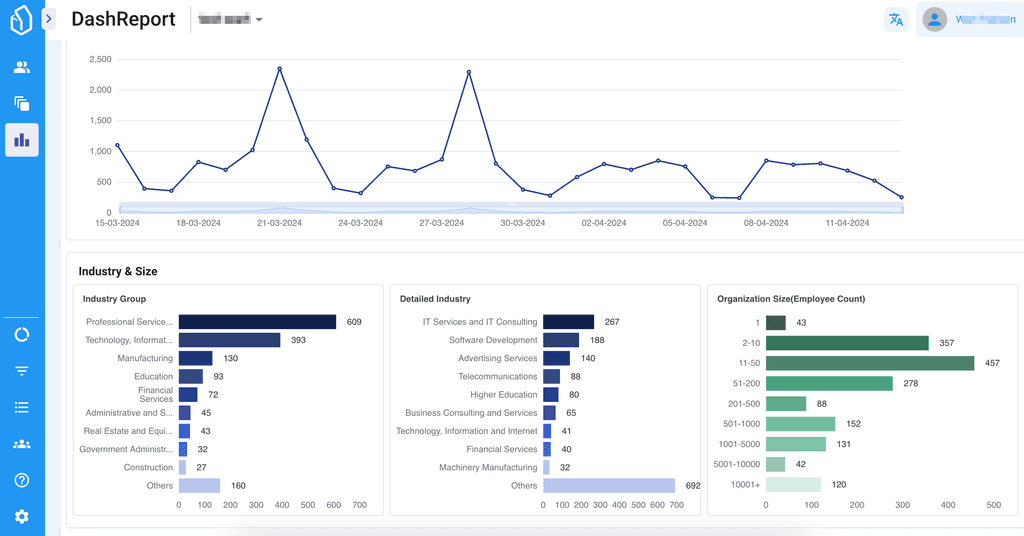

Supercharge your marketing results with LeadBoxer!
Analyze campaigns and traffic, segement by industry, drilldown on company size and filter by location. See your Top pages, top accounts, and many other metrics.


Supercharge your marketing results with LeadBoxer!
Analyze campaigns and traffic, segement by industry, drilldown on company size and filter by location. See your Top pages, top accounts, and many other metrics.


Supercharge your marketing results with LeadBoxer!
Analyze campaigns and traffic, segement by industry, drilldown on company size and filter by location. See your Top pages, top accounts, and many other metrics.


